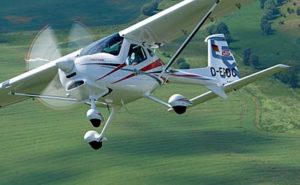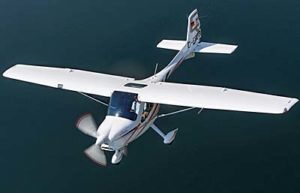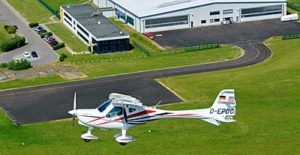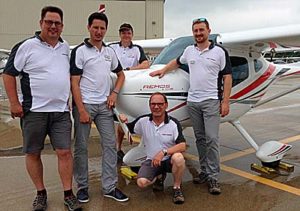
See the new Remos GXiS, a Mercedes of Light-Sport Aircraft at AirVenture 2016; spaces 331-332 near the Theater in the Woods.
Oshkosh is on! OK, not today. The big show starts tomorrow, but you wouldn’t know it as airplanes are already arriving in droves and the grounds are rapidly filling. Time for EAA’s summer celebration of flight to begin!
Although I’m a longtime regular, today I did something I’ve never done. I flew out of KOSH and then returned. If you’ve never flown into Oshkosh during AirVenture, you may not know what an experience such an arrival can be. This is the world’s busiest airport for one week. Airplanes arrive every few minutes and all of them do so in a unique, follow-the-plane-in-front-of-you method where no pilot uses the radio. Departing was fairly simple. Arriving is always an eye-opening experience.
I did my departure and reentry with Remos PR & Marketing guy Patrick Holland-Moritz, a former German aviation magazine writer. We flew in the brand new Remos GXiS. Flying into Oshkosh was a repeat treat for me, but I think Patrick was blown away by the flowing river of airplanes of all types. This became even more interesting when the airport had to close one runway due to an incident. As on any freeway, this backed up and snarled traffic. Airplanes were circling back to get in line and our heads were swiveling on our shoulders trying to follow the traffic gaggle around us. Whew!

GXiS features the Rotax 912 iS fuel-injected engine in what may be the best-yet implementation of the fuel efficient powerplant.
Remos remains one of the major brands in the U.S. LSA fleet but the company endured a major setback in 2014 when it was declared insolvent, roughly the equivalent of U.S. bankruptcy. In the last couple years, the German company has found new investors, reorganized, and clawed its way back into the business. Spending by their American representatives in the heydays of LSA helped trigger the problem. The revitalized company has a far more realistic plan of recovery.
One thing that didn’t change much was the basic Remos GX series. They have a new model now and perhaps the period they used to reorganize came with a benefit. Remos did not immediately embrace the new Rotax 912 iS fuel-injected 912. The earliest installations by other manufacturers had some challenges (as with any new product). Remos was able to design their new install after some of the earlier bumps has been smoothed. The GXiS result was good… no, make that excellent.
I have more than 120 hours experience flying with the 912 iS. It’s great like all Rotax engines but it introduced complications and I experienced them. However, now that is well sorted and Remos had time to thoroughly engineer their solutions. The German engineering team said everything from the firewall forward is new, not only the cowling and spinner that you see. All electronics along with heating and cooling and other details are fresh.
In my evaluation as a pilot, this is best implementation of the 912 iS I have seen.

GXiS flies over the Pasewalk, Germany factory producing the highly upgraded Light-Sport Aircraft. all flight photos courtesy Remos
I’m going to write about the flying qualities but first I want to tell you about the relatively mundane matter of starting a 912 iS. Boring, huh? You might not think so after you first confront Lane A, Lane B lights and some of the other new features of the 912 iS. In their efforts to ease the transition to a computer controlled engine, Rotax made the starting and run-up process similar to what pilots are used with magneto and carb heat checks. The odd thing is that the computer is essentially already doing all this for you so the pilot’s workload can be reduced. Remos engineers understood this and worked hard to make it easier.
When you rent a car anywhere in the world, you expect the car to operate simply and largely as you expect, right? Airplanes aren’t so simple. While we pilots might like to show off our great knowledge, why jump through unneeded hoops?
In the Remos GXiS you turn the key switch to “Avionics” which lights up the panel but does not turn on all other electrical systems. When you switch to “Engine,” all electrics are engaged and then you merely push the Engine Start button. As with many modern cars, that’s it. The Rotax starts instantly as always and you can carry on with flight preparations. Remos calls the system “SMARTstart“…and it is.
While the Remos team and I discussed all these changes we understood “simplification” is too basic a term and not very sexy. True to his marketing role, Patrick created the term “smartification.” Bravo! A new word is needed for this renewed LSA.
Instead of delving deeply into every change made to GXiS, let me hit some highlights. The throttle is now quadrant style instead of a knob on the panel. Throttle and brake use one lever: forward to go, aft to slow. Flaps are now preset. You move the flap-shaped lever to the position you want and go to your next task. Even cabin heating is new with a system that uses the engine’s warm fluid rather than drawing from air surrounding the exhaust system. Changes go deeper so interested buyers will want to contact Remos for all the details.

Meet Team Remos from Germany at EAA AirVenture Oshkosh 2016: (L-R) Christian, Daniel, Patrick, Jürgen (kneeling), and Paul.
Finally, the flying part. Ah, this is the best (not to diminish the other excellent upgrades to the GX series).
Briefly, GXiS flies beautifully. It’s been a while since I flew Remos and this is one deluxe flying machine. As my title indicates this is a Mercedes of Light-Sport Aircraft. Overall the machine is civilized and luxurious. Handling is superlative, light but not twitchy; responsive yet stable; very nice and a form of warm tribute to original designer, Lorenz Kreitmayr.
Despite approaching amid a large flock of airplanes all anxious to land after the delays on the all-in-a-line approach path, my effort with GXiS went well although I can’t claim the smoothest touchdown I’ve ever made. Landing on one of five large dots on a runway with someone landing ahead of you and behind has a way of distracting one’s concentration. Yet in control authority, I lacked for nothing and again, that smooth, easy handling pays a benefit.
Besides the SMARTstart controls everyone will love (I predict), Remos is laid out as comfortably as the interior treatment is deluxe and handsome. GXiS is not the widest cabin in the LSA fleet but was certainly comfortable. In-flight visibility is large especially while banked thanks to the large skylight.
To give some balance to my overwhelmingly positive reaction to GXiS, I note the seats adjust in three positions but only while on the ground. Baggage is accessed by removing the seats, though that’s easy enough, and you have places for gear you need in flight.
The only remaining downside to the new Remos GXiS is a price tag close to $200,000. So, this won’t be for everyone, but if you would consider a fine German automobile, you should by all means check out GXiS. This SLSA should satisfy even the most discerning buyers.


Leave a Reply